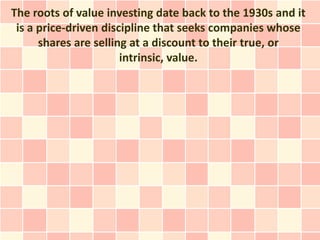Just How Important Is Value Investing?
•Download as PPTX, PDF•
0 likes•208 views
Visit http://www.AubreyTreasure.info/ for more info
Report
Share
Report
Share

Recommended
The much-heralded decoupling of the financial markets between developed, emerging and frontier markets met its nemesis in the 2008/9 global financial crisis- The Great Recession. For the believer in a diversified global basket of stocks or indices this came as a crushing blow. This notwithstanding, we still believe that a globally-diversified passive buy-and-hold strategy provides the best chance at maximising net investment return. We test this empirically.Global Investment Opportunities- a low-cost passive 'buy-and-hold' strategy

Global Investment Opportunities- a low-cost passive 'buy-and-hold' strategyBlockchain and CryptoAsset (K) Ltd.
More Related Content
What's hot
The much-heralded decoupling of the financial markets between developed, emerging and frontier markets met its nemesis in the 2008/9 global financial crisis- The Great Recession. For the believer in a diversified global basket of stocks or indices this came as a crushing blow. This notwithstanding, we still believe that a globally-diversified passive buy-and-hold strategy provides the best chance at maximising net investment return. We test this empirically.Global Investment Opportunities- a low-cost passive 'buy-and-hold' strategy

Global Investment Opportunities- a low-cost passive 'buy-and-hold' strategyBlockchain and CryptoAsset (K) Ltd.
What's hot (20)
Global Investment Opportunities- a low-cost passive 'buy-and-hold' strategy

Global Investment Opportunities- a low-cost passive 'buy-and-hold' strategy
Jargon Buster - Alittle learning from Currency UK Ltd (currency exchange brok...

Jargon Buster - Alittle learning from Currency UK Ltd (currency exchange brok...
Mutual funds involve risk including the possible loss of principal

Mutual funds involve risk including the possible loss of principal
Similar to Just How Important Is Value Investing?
Similar to Just How Important Is Value Investing? (20)
Introduction to Investing in the Stock Market.pptx

Introduction to Investing in the Stock Market.pptx
How Super Investors Manage Risk in their Portfolios.pptx

How Super Investors Manage Risk in their Portfolios.pptx
Security-Analysis-and-Portfolo-Management-Unit-1-Dr-Asma-Khan.pptx

Security-Analysis-and-Portfolo-Management-Unit-1-Dr-Asma-Khan.pptx
JP Morgan Absolute Return Investing in Fixed Income

JP Morgan Absolute Return Investing in Fixed Income
Just How Important Is Value Investing?
- 1. The roots of value investing date back to the 1930s and it is a price-driven discipline that seeks companies whose shares are selling at a discount to their true, or intrinsic, value.
- 2. Investors that are growth-oriented focus on firms whose earnings are growing at a rapid pace which is a quality that makes them highly sought after but for value investors, what they seek are companies that are temporarily out of favor. Their shares may be depressed due to factors ranging from company-specific issues to shifting investor sentiment, poor economic conditions, cyclical trends or an overall market decline. There are times when they are being ignored by the market for no good reason.
- 3. There are three factors that have amply made the case for the value style of investing over the past 25 years and these are performance, diversification and risk control.
- 4. Facts about performance. First and foremost, value investing as a strategy has done well over time, rewarding investors with strong risk-adjusted performance. This has actually been true over the past quarter-century.
- 5. Dividends have and continue to be a significant component of the stock market's total returns, particularly those of value stocks and this is another important thing to keep in mind.
- 6. Diversification. Value and growth stocks have tended to move in different cycles over time. Growth stocks tend to outperform value shares and vice versa when they are in favor. That knowledge encourages many investors to construct portfolios employing both value and growth strategies, helping to ensure that they have equity investment with the potential to perform in changing market environments.
- 7. More to the point, the value strategy has more than held its own against its growth counterpart. The outperformance of value has been particularly pronounced in recent years.
- 8. Risk control. Value stocks by their nature generally tend to be less volatile than their growth counterparts. Value firms are better positioned to withstand market declines as well because their shares are typically selling at depressed prices. Meanwhile, as those expectations change, shares of growth companies normally have higher earnings expectations that are built into their prices and are subject to wider price swings.